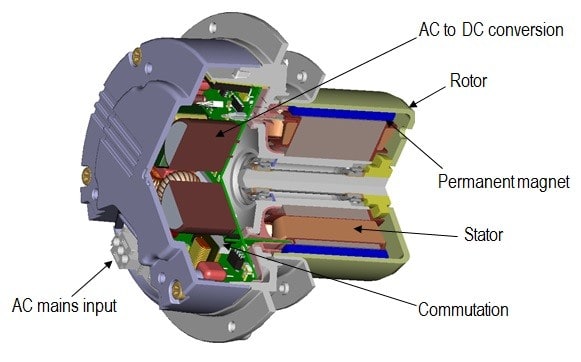Energy Saving EC Motor (ESM) - Direct and Indirect reduction in energy consumption
Follow articleHow do you feel about this article? Help us to provide better content for you.
Thank you! Your feedback has been received.
There was a problem submitting your feedback, please try again later.
What do you think of this article?
Electronically Commutated (EC) Motor technology – A simple opportunity to save energy.
‘All newly developed ebm-papst products must be technologically and economically superior to its predecessor.’ This is at the heart of the philosophy which is the ebm-papst Greentech brand. Greentech motors make use of permanent magnets and electronic commutation to minimise power use and maximise efficiency.
Developed in the 1960s, the first electronically commutated motors were used in small compact fans powered by Direct Current (DC) power supplies. Once available, they quickly became the norm for providing cooling in Information and Communication Technology. Being powered by DC provided the benefit of making the fan universal; fans could continue to run during a power loss using uninterruptible power supply systems and fan selection no longer needed to take into account whether the AC mains frequency was 50 or 60Hz.
DC motors use a simple stator winding to excite a magnetic field which attracts/repels permanent magnets in the rotor dependant on the direction of current flow through the winding. To achieve continuous rotation the direction of current flow needs to be reversed as the magnets move in relation to the stator. Some DC motors available at the time used carbon brushes on a commutator to reverse the flow of current in the rotor. This type of commutation had two main drawbacks: one was that the brushes required replacement after a period of time and the other was that this made the DC motor electrically noisy which could affect other electrical devices close by. To resolve these issues, electronic commutation was devised using hall-effect sensors to provide maintenance and interference-free operation of the motor.
Adding electronics to the motor to co-ordinate commutation also provided an opportunity to add in control and monitoring functions. The fan powered by the motor could now respond to external signals that would change its speed and output signals could be produced to provide tachometer or fan status output to a monitoring device.
By contrast, traditional AC induction motors rely on inducing a magnetic field and current flow from the stator into the rotor to create movement. This process involves a number of losses in transferring the energy from the stator to the rotor including: induction loss (mass losses in the laminations), air gap loss, winding losses, rotor resistance loss.
In order to change the speed of the motor, an external device would be required either to reduce the voltage to the windings (transformer, Variac or triac voltage reduction) or by changing the frequency (Inverter drives). Use of these speed control devices causes weak field conditions, introducing slip losses which slow the motor. The slip losses are energy losses which are dissipated as heat causing the motor to run hot, reducing the life expectancy of the grease in the bearings and shortening the life of the fan.
More recently, electronically commutated motors have been designed which incorporate the power supply converting single or three phase mains electricity into high voltage DC onboard allowing our EC motors to connect directly to mains power without the need for a separate power supply. Using mains connected EC motors the range of products has increased from the small compact fans of a few watts power consumption to 12kW for large diameter industrial fans.
The table below illustrates the efficiencies that can be expected of each type of motor…
|
Motor Type |
Typical efficiency |
|
Single-phase shaded pole (up to 50W output) |
20% |
|
Single-phase capacitor motor (Up to 750W output) |
50% |
|
Three phase motor (EFF2 – up to 10kW) |
80-85% |
|
DC, single & three phase EC motor (Up to 12kW) |
>90% |
Changing from a shaded pole motor to an EC energy saving motor is something that supermarkets worldwide have taken advantage of. The switch to EC technology reduces the direct motor power consumption and the consumption of the refrigeration plant by minimising the amount of heat dissipated into the refrigerated environment.
Case Study - Supermarket Retail Display Case
In the chilled food aisles of a supermarket, there are reach-in cold display cases which keep fresh produce at an acceptable temperature for safety and quality purposes. These cases use a refrigerated heat exchanger in their base, over which air is blown to chill the air to a pre-set temperature (approximately 1 to 2oC).
The fans that blow the air over the heat exchanger and circulate the air around the display case have traditionally used a shaded pole motor fitted with a 200mm diameter impeller.
The Shaded Pole Motor Solution
A shaded pole motor delivers approximately 7 Watts of power to the impeller and is approximately 22% efficient. This means it is drawing 31 Watts of electrical power. The difference of 24 Watts (31-7W) is being dissipated by the motor as heat into the refrigerated area of the cabinet. The refrigeration plant is required to provide an extra 8 watts of refrigeration energy in order to remove this dissipated heat.
In total using a shaded pole motor in this cold application wastes 32W of electrical energy each hour it operates which adds up to approximately 280kW of electricity per annum per motor. If you consider the number of motors used in a typical medium-sized supermarket, this can add up to many megawatts of energy wasted each year.
The Electronically Commutated Energy Saving Motor Solution

Energy Saving Motor Comparison Video
The video below demonstrates the savings possible using an EC motor whilst performing an equivalent task of a shaded pole motor…
In addition, the use of an electronically commutated motor means that when the store is not trading, night blinds can be pulled down to keep the refrigerated air inside the cabinet. This means that the fans can be controlled down to a lower speed, saving more energy with lower running costs.
Summary
In summary, replacing older induction motor technology with energy saving EC motors can dramatically reduce direct and indirect energy consumption. Lower energy consumption saves on running costs and in some cases, the investment made to switch to EC can be paid back by the energy savings within a 12 to 18-month period.
Click here to download ebm-papst's Fans and motors for refrigerated display cabinets








